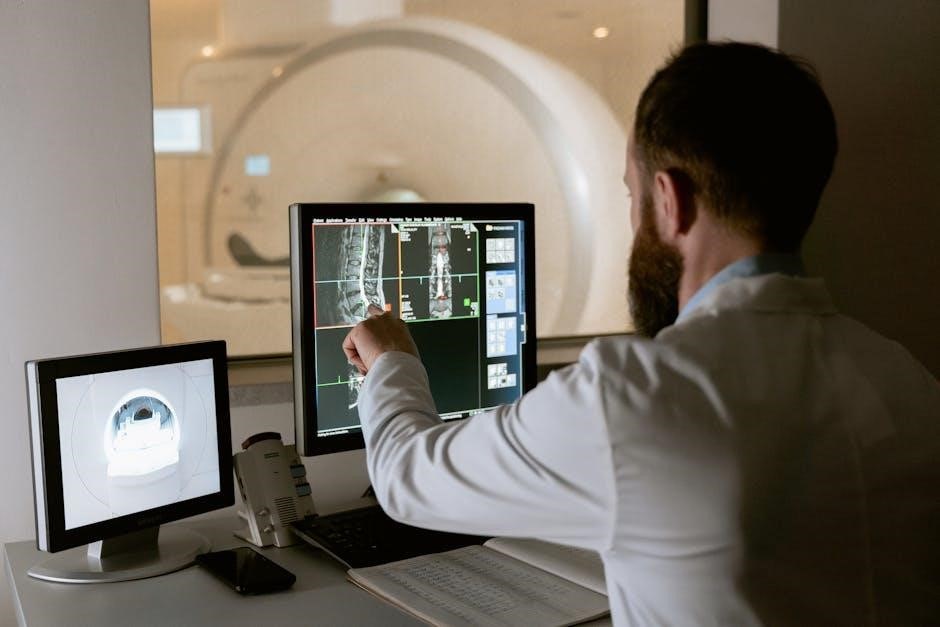The Mann Assessment of Swallowing Ability (MASA) is a comprehensive clinical tool developed by Giselle Mann to evaluate swallowing function in patients with dysphagia. Designed for bedside use, it assesses oral and pharyngeal phases, providing insights for diet recommendations and treatment plans to ensure safe swallowing.
1.1 Overview of the MASA
The Mann Assessment of Swallowing Ability (MASA) is a clinical tool designed to evaluate swallowing function in patients with dysphagia. It assesses 24 key areas, including oral and pharyngeal phases, to guide diet and fluid recommendations, ensuring safe swallowing and reducing risks like aspiration pneumonia. Widely used in bedside evaluations, it supports tailored treatment plans for improved patient outcomes.
1.2 Importance of Swallowing Assessment in Clinical Practice
Swallowing assessments like the MASA are critical in clinical practice to identify dysphagia and aspiration risks, preventing complications such as pneumonia. Accurate evaluations ensure safe dietary recommendations, enhancing patient safety and quality of life, while guiding targeted interventions for improved swallowing function and overall health outcomes in diverse patient populations.
MASA: Background and Development
The Mann Assessment of Swallowing Ability (MASA) was developed by Giselle Mann in 2002 as a reliable bedside evaluation tool for assessing swallowing function in patients with dysphagia.
2.1 Creator and Purpose
The Mann Assessment of Swallowing Ability (MASA) was created by Giselle Mann, a renowned speech-language pathologist, to provide a standardized tool for evaluating swallowing function in patients with dysphagia. Its primary purpose is to guide clinical decision-making, ensuring safe and effective treatment plans tailored to individual patient needs.
2.2 Historical Context and Evolution
Developed in 2002 by Giselle Mann, the MASA emerged as a response to the need for a reliable, bedside swallowing assessment tool. Over time, it has evolved to incorporate feedback from clinical use, refining its scoring system and assessment criteria to enhance accuracy and applicability across diverse patient populations.
2.3 Significance in Dysphagia Diagnosis
The MASA is a pivotal tool in dysphagia diagnosis, offering a structured evaluation of swallowing function. It identifies risks like aspiration and impaired bolus clearance, guiding targeted interventions. By assessing oral and pharyngeal phases, the MASA enables early detection of swallowing disorders, facilitating timely treatment and reducing complications such as aspiration pneumonia;

Test Description and Structure
The MASA evaluates oral and pharyngeal swallowing phases, assessing 24 areas like alertness, cooperation, and swallow integrity. Designed for bedside use, it provides a detailed profile to guide dietary and treatment plans.
3.1 Components of the MASA
The MASA comprises detailed assessments of alertness, cooperation, and swallow integrity. It evaluates oral functions such as tongue movement, lip seal, and bolus preparation, alongside pharyngeal aspects like gag reflex and bolus clearance. These components provide a comprehensive evaluation of swallowing ability, guiding clinical decisions for safe dietary recommendations and interventions.
3.2 Oral and Pharyngeal Phase Evaluation
The MASA evaluates the oral phase by assessing tongue movement, bolus formation, and oral transit, while the pharyngeal phase examines gag reflex, pharyngeal clearance, and coughing. This dual-phase assessment provides insights into swallowing mechanics, aiding in the identification of dysphagia and guiding targeted interventions for improved swallowing safety and efficiency.
3.4 Key Assessments: Alertness, Cooperation, and Swallow Integrity
The MASA evaluates alertness (response to speech), cooperation (patient engagement), and swallow integrity (dysphagia and aspiration risks). These assessments determine the patient’s ability to safely manage food and fluids, guiding clinical decisions to prevent complications like aspiration pneumonia and ensure effective swallowing rehabilitation strategies.
Test Administration and Scoring
The MASA is administered bedside, evaluating 24 areas of swallowing function. Scoring assesses alertness, cooperation, and swallow integrity, guiding clinical decisions for safe dietary and fluid management.
4.1 Step-by-Step Administration Process
The MASA is administered at the bedside, beginning with patient preparation and positioning. Assess alertness, cooperation, and swallowing integrity. Evaluate oral and pharyngeal phases, noting tongue movement, bolus clearance, and cough reflex. Document findings systematically to ensure accurate scoring and clinical interpretation.
4.2 Scoring Criteria and Interpretation
The MASA uses a structured scoring system, rating 24 areas of swallowing function on a scale from 2 to 10. Higher scores indicate better ability. Key areas include alertness, cooperation, dysphagia, and aspiration. Scores guide clinical decisions, with interpretations categorizing swallowing safety and recommending dietary adjustments to minimize risks like aspiration pneumonia.
4.3 Clinical Application of Scores
MASA scores guide clinical decisions, tailoring interventions and diet recommendations to patient needs. Scores identify dysphagia severity and aspiration risks, enabling personalized treatment plans. Higher scores suggest safer swallowing, while lower scores may necessitate modified diets or further interventions to prevent complications and ensure patient safety.
MASA Scoring Sheet and Interpretation
The MASA scoring sheet evaluates swallowing function, providing clear guidelines for interpreting results. It assesses key areas like alertness, cooperation, and swallow integrity, guiding diet recommendations and identifying aspiration risks; The structured system ensures accurate clinical decisions, making it a valuable tool for healthcare professionals.
5.1 Detailed Scoring System
The MASA employs a detailed scoring system, evaluating 24 areas of swallowing function. Each aspect, such as alertness, cooperation, and swallow integrity, is scored on a scale. Higher scores indicate better function, while lower scores suggest impairment. The system provides objective criteria, ensuring consistent assessments and guiding targeted interventions for improved patient outcomes effectively.
5.2 Diet and Fluid Recommendations Based on Scores
MASA scores guide dietary adjustments, ensuring safe eating and drinking. Higher scores support normal diets, while lower scores recommend textured or pureed foods. Fluid consistency is tailored based on aspiration risks, with thicker liquids for safer swallowing. These recommendations aim to balance nutrition with reduced choking and aspiration risks, improving patient safety and outcomes effectively.
5.3 Identifying Dysphagia and Aspiration Risks
MASA scores help identify dysphagia and aspiration risks by evaluating symptoms like difficulty swallowing, coughing, or choking. The assessment categorizes risks as definite, probable, or unlikely, guiding clinical decisions to minimize complications such as aspiration pneumonia and ensure patient safety through targeted interventions and monitoring.

Reliability and Validity of the MASA
Research supports the MASA’s reliability and validity, effectively predicting health outcomes like pneumonia recurrence. Its structured scoring system ensures consistent evaluations, validated across diverse clinical populations for accuracy and effectiveness in swallowing assessments.
6.1 Research Supporting MASA Effectiveness
Research highlights the MASA as a reliable tool for assessing swallowing function, demonstrating strong predictive validity for pneumonia recurrence in elderly patients. Studies validate its effectiveness in diverse clinical populations, including those with tracheostomy tubes and respiratory conditions, confirming its accuracy in predicting aspiration risks and guiding dietary recommendations effectively.
6.2 Comparative Studies with Other Assessment Tools
Comparative studies with tools like FEES and VFSS highlight MASAs unique ability to assess 24 specific swallowing areas, offering a detailed evaluation. While other tools focus on visualization, MASA provides a user-friendly, cost-effective clinical assessment. Research confirms its reliability in predicting aspiration risks, though combining it with instrumental tools may enhance diagnostic accuracy for complex cases.
6.3 Clinical Utility in Diverse Patient Populations
MASAs clinical utility extends across diverse populations, including neurological patients, elderly, and those with respiratory or oncological conditions. Its comprehensive evaluation identifies specific deficits, guiding targeted interventions and reducing complications like aspiration pneumonia, thus improving clinical outcomes and patient safety across various clinical settings.
Clinical Applications and Patient Populations
The MASA is widely applied in neurological, geriatric, and respiratory care, aiding in swallowing disorder management. It guides interventions, diet plans, and reduces aspiration risks in diverse clinical settings.
7.1 Use in Neurological Disorders (e.g., Stroke, Parkinson’s Disease)
The MASA is particularly valuable for assessing swallowing function in neurological disorders like stroke and Parkinson’s disease. It evaluates oral and pharyngeal phases, identifying deficits in tongue movement, bolus clearance, and cough reflex. This enables targeted rehabilitation plans to improve swallowing safety and overall quality of life for patients with neurological impairments.
7.2 Application in Geriatric and Respiratory Patient Care
The MASA is widely applied in geriatric and respiratory care to assess swallowing difficulties, particularly in elderly patients and those with conditions like COPD. It evaluates cough reflex, bolus clearance, and saliva management, guiding personalized dietary recommendations to reduce aspiration risks and improve respiratory safety in vulnerable populations.
7.3 Role in Oncology and Palliative Care
The MASA plays a crucial role in oncology and palliative care by assessing swallowing function in patients with cancer, aiding in tailored diet plans to maintain nutrition and comfort. It helps identify dysphagia, guiding interventions to prevent aspiration and improve quality of life for patients with complex medical conditions.

MASA and Its Role in Swallowing Disorders Management
The MASA is a vital tool in managing swallowing disorders, guiding targeted interventions and ensuring patient safety by identifying dysphagia risks and informing personalized treatment strategies effectively.
8;1 Guiding Treatment Plans and Interventions
The MASA provides actionable insights to guide treatment plans, ensuring interventions address specific swallowing deficits. By identifying impaired functions like bolus clearance or tongue movement, it enables tailored strategies to enhance safety and efficiency in swallowing, reducing risks of aspiration and improving overall patient outcomes effectively.
8.2 Monitoring Progress and Outcomes
The MASA facilitates consistent monitoring of patient progress, enabling clinicians to track improvements or declines in swallowing function over time. Regular reassessments using the tool’s structured scoring system help identify areas requiring continued intervention, ensuring tailored adjustments to treatment plans and optimizing patient outcomes effectively.
8.3 Reducing Complications Like Aspiration Pneumonia
The MASA helps identify aspiration risks early, enabling targeted interventions to prevent complications like aspiration pneumonia. By assessing swallow integrity and bolus clearance, it guides safe dietary recommendations, reducing the likelihood of respiratory infections and improving patient safety and overall clinical outcomes significantly.

Accessing the MASA PDF and Resources
The MASA PDF is available for download from various clinical resources, including Sarasota CCW, offering a comprehensive guide to swallowing assessment, scoring sheets, and instructional materials.
9.1 Downloading the MASA Instruction Manual
The MASA Instruction Manual can be downloaded as a PDF from reputable sources like Sarasota CCW. It provides detailed guidelines for administering the assessment, interpreting scores, and using the scoring sheet effectively, ensuring accurate evaluations of swallowing function and appropriate clinical interventions for patients with dysphagia.
9.2 Using the MASA Scoring Sheet
The MASA Scoring Sheet is a structured tool for evaluating swallowing function, assessing alertness, cooperation, and swallow integrity. It scores oral and pharyngeal phases, providing clear guidelines for diet and fluid recommendations. The sheet helps identify dysphagia and aspiration risks, guiding clinical decisions for safe patient care and treatment planning.
9.3 Additional Clinical Tools and Support Materials
Beyond the MASA PDF, additional resources include instructional manuals and clinical pathways for stroke rehabilitation. These tools provide detailed guidelines for healthcare professionals, aiding in comprehensive swallowing disorder management. They complement the MASA by offering structured approaches for treatment planning, progress monitoring, and reducing complications like aspiration pneumonia, ensuring holistic patient care.

Best Practices for Administering the MASA
Proper training and certification are essential for accurate MASA administration. Ensuring patient cooperation and using standardized scoring criteria help deliver reliable results, guiding effective treatment plans.
10.1 Training and Certification for Healthcare Professionals
Healthcare professionals should undergo specialized training to master the MASA administration. Certification ensures proficiency in evaluating swallowing mechanics, interpreting scores, and applying results to patient care. Regular updates and workshops help maintain expertise, ensuring accurate and reliable assessments that inform effective treatment strategies for dysphagia management and patient safety.
10.2 Ensuring Accurate and Reliable Assessments
Accurate MASA assessments require adherence to standardized administration procedures and scoring criteria. Clinicians should minimize environmental distractions, ensure patient comfort, and use the MASA PDF resources for guidance. Regular training and inter-rater reliability checks further enhance consistency, ensuring reliable and valid results that guide effective patient care and treatment decisions.
10.3 Integrating MASA into Multidisciplinary Care Plans
Integrating MASA into multidisciplinary care plans ensures a collaborative approach to patient management. Speech-language pathologists, physicians, and other specialists use MASA insights to develop tailored strategies, promoting consistency and coherence in treatment. This teamwork enhances patient outcomes by aligning swallowing assessments with overall care goals, fostering a holistic approach to rehabilitation and recovery.
Case Studies and Real-World Applications
Case studies demonstrate MASA’s effectiveness in clinical settings, showcasing its role in improving swallowing outcomes for patients with dysphagia. Real-world applications highlight its practicality in guiding interventions and enhancing patient care through evidence-based strategies.
11.1 Successful Outcomes in Clinical Settings
The MASA has been instrumental in managing dysphagia, guiding interventions and improving patient outcomes. Clinical cases highlight its effectiveness in identifying swallowing impairments, particularly in stroke survivors and geriatric patients, enabling tailored treatment plans that enhance safety and quality of life.
11.2 Challenges and Limitations in Practice
Despite its effectiveness, the MASA has limitations, such as reliance on clinical observation rather than instrumental measures. It may not detect subtle swallowing deficits, particularly in complex cases. Additionally, its effectiveness depends on patient cooperation and alertness, potentially limiting its use in severely impaired individuals.
11.3 Patient-Centered Approaches Using MASA
The MASA facilitates patient-centered care by tailoring assessments to individual needs, ensuring personalized interventions. Its detailed scoring guides customized treatment plans, enhancing patient outcomes and satisfaction. By incorporating patient preferences and goals, the MASA supports a holistic approach to swallowing rehabilitation, fostering improved overall quality of life.

Future Directions and Advances in Swallowing Assessment
Future advancements in swallowing assessment may include integrating technology like AI and telehealth into tools such as the MASA to enhance accessibility and expand clinical applications.
12.1 Potential Enhancements to the MASA
Future enhancements to the MASA may include integrating advanced technologies like AI for real-time analysis and telehealth compatibility. Expanding the assessment to cover emerging patient populations and refining the scoring system for greater precision are also potential improvements. These updates aim to enhance clinical utility and patient outcomes.
12.2 Integration with Technology and Telehealth
The MASA can be enhanced by integrating it with digital platforms for remote assessments via telehealth. This allows clinicians to evaluate patients virtually, ensuring accessibility for those with mobility issues. Digital MASA tools could streamline data collection, scoring, and reporting, and integrate with electronic health records for better continuity of care.
12.3 Expanding Applications in Emerging Clinical Areas
The MASA shows potential for use in emerging clinical areas such as pediatric care, post-COVID rehabilitation, and critical care settings. Its structured assessment can benefit patients with unique swallowing challenges, aiding in tailored interventions and improving outcomes in diverse populations with evolving healthcare needs.
